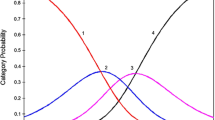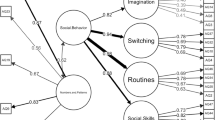Abstract
We assessed the reliability and validity of the Turkish version of the autism spectrum quotient (AQ)-adolescent. Three assessment groups of adolescents, aged 11–18, were: 80 with Asperger syndrome/high-functioning autism (AS/HFA), 71 with other psychiatric disorders (PDs; 35 major depression, 18 obsessive–compulsive disorder, 18 social phobia), and 249 healthy controls. The scores of the AS/HFA group were significantly higher than the healthy control and PD groups. Cronbach α value was 0.829. Ordinal alpha value was 0.90. We showed the AQ-adolescent four-factor structure in the factor analysis. In the test–retest of AQ-adolescent and subscale scores, “very strong” significant correlation values were detected. A cut-off score of 24 best distinguished the autism group from healthy controls with 0.975 sensitivity and 0.991 specificity.



Similar content being viewed by others
References
American Psychiatric Association. (2000). Diagnostic and statistical manual of mental disorders (4th ed.). American Psychiatric Association.
American Psychiatric Association. (2013). Diagnostic and statistical manual of mental disorders (5th ed.). American Psychiatric Association.
Austin, E. J. (2005). Personality correlates of the broader autism phenotype as assessed by the Autism Spectrum Quotient (AQ). Personality and Individual Differences, 38(2), 451–460.
Auyeung, B., Baron-Cohen, S., Wheelwright, S., & Allison, C. (2008). The autism spectrum quotient: Children’s version (AQ-Child). Journal of Autism and Developmental Disorders, 38(7), 1230–1240.
Baron-Cohen, S., Hoekstra, R. A., Knickmeyer, R., & Wheelwright, S. (2006). The autism-spectrum quotient (AQ)—Adolescent version. Journal of Autism and Developmental Disorders, 36(3), 343–350.
Baron-Cohen, S., Wheelwright, S., Skinner, R., Martin, J., & Clubley, E. (2001). The autism-spectrum quotient (AQ): Evidence from asperger syndrome/high-functioning autism, malesand females, scientists and mathematicians. Journal of Autism and Developmental Disorders, 31(1), 5–17.
Broadbent, J., Galic, I., & Stokes, M. (2013). Validation of autism spectrum quotient adult version in an Australian sample. Autism Research and Treatment. https://doi.org/10.1155/2013/984205
Ehlers, S., Gillberg, C., & Wing, L. (1999). A screening questionnaire for Asperger syndrome and other high-functioning autism spectrum disorders in school age children. Journal of Autism and Developmental Disorders, 29(2), 129–141.
English, M. C. W., Gignac, G. E., Visser, T. A. W., Whitehouse, A. J. O., & Maybery, M. T. (2020). A comprehensive psychometric analysis of autism-spectrum quotient factor models using two large samples: Model recommendations and the influence of divergent traits on total-scale scores. Autism Research, 13(1), 45–60. https://doi.org/10.1002/aur.2198
Gomez, R., Stavropoulos, V., & Vance, A. (2019). Psychometric properties of the autism spectrum quotient: Children’s version (AQ-Child). Journal of Autism and Developmental Disorders, 49(2), 468–480.
Gökler, B., Ünal, F., Pehlivantürk, B., Kültür, E. Ç., Akdemir, D., & Taner, Y. (2004). Reliability and validity of schedule for affective disorders and schizophrenia for school age children-present and lifetime version-Turkish Version (K-SADS-PL-T). Turkish Journal of Child and Adolescent Mental Health, 11(3), 109–116.
Hoekstra, R. A., Bartels, M., Cath, D. C., & Boomsma, D. (2008). Factor structure, reliability and criterion validity of the Autism-Spectrum Quotient (AQ): A study in Dutch population and patient groups. Journal of Autism and Developmental Disorders, 38(8), 1555–1566.
Hurst, R., Mitchell, J., Kimbrel, N., Kwapil, T., & Nelson-Gray, R. (2007). Examination of the reliability and factor structure of the Autism Spectrum Quotient (AQ) in a non-clinical sample. Personality and Individual Differences, 43(7), 1938–1949.
Kaufman, J., Birmaher, B., Brent, D., Rao, U., Flynn, C., & Moreci, P. (1997). Schedule for affective disorders and schizophrenia for school-age children-present and lifetime version (K-SADS-PL): Initial reliability and validity data. Journal of American Academy Child and Adolescent Psychiatry, 36(1997), 980–988.
Ko, H.-Y., Lee, W.-H., Won, E.-K., Ban, J. J., Jung, D. E., & Kim, Y. (2018). The reliability and validity of the Korean version of the autism-spectrum quotient. Psychiatry Investigation, 15(8), 783.
Kose, S., Bora, E., Eremis, S., & Aydin, C. (2010). Psychometric features of Turkish version of Autism-Spectrum Quotient. Anadolu Psikiyatri Dergisi-Anatolian Journal of Psychiatry, 11(3), 253–260.
Köse, S., Özbaran, B., Yazgan, Y., Baytunca, M. B., Bildik, T., Erermiş, S., & Aydin, C. (2017). The psychometric properties of Turkish version of autism spectrum screening questionnaire in children aged 6–18 years. Turkish Journal of Psychiatry, 28(4), 268–277.
Montgomery, C. B., Allison, C., Lai, M.-C., Cassidy, S., Langdon, P. E., Baron-Cohen, S. J. J., et al. (2016). Do adults with high functioning autism or Asperger syndrome differ in empathy and emotion recognition? Journal of Autism and Developmental Disorders, 46(6), 1931–1940.
Poon, V. W. K., Shu, D. S. T., Chan, R. W. S., Leung, C. N. W., & Leung, P. W. L. (2020). Comparing the psychometric properties of the self- and parent-report versions of autism-spectrum quotient-adult in Hong Kong (AQ-Adult-HK). Journal of Autism and Developmental Disorders, 50(2), 524–528. https://doi.org/10.1007/s10803-019-04276-7
Ruta, L., Mazzone, D., Mazzone, L., Wheelwright, S., & Baron-Cohen, S. (2012). The Autism-Spectrum Quotient—Italian version: A cross-cultural confirmation of the broader autism phenotype. Journal of Autism and Developmental Disorders, 42(4), 625–633.
Sonié, S., Kassai, B., & Pirat, E. (2013). The French version of the autism-spectrum quotient in adolescents: A cross-cultural validation study. Journal of Autism and Developmental Disorders, 43(5), 1178–1183.
Swineford, L. B., Thurm, A., Baird, G., Wetherby, A. M., & Swedo, S. J. J. (2014). Social (pragmatic) communication disorder: A research review of this new DSM-5 diagnostic category. Journal of Neurodevelopmental Disorders, 6(1), 1–8.
Wakabayashi, A., Baron-Cohen, S., Uchiyama, T., Yoshida, Y., Tojo, Y., Kuroda, M., et al. (2007). The autism-spectrum quotient (AQ) children’s version in Japan: A cross-cultural comparison. Journal of Autism and Developmental Disorders, 37(3), 491–500.
Wakabayashi, A., Baron-Cohen, S., Wheelwright, S., & Tojo, Y. (2006). The Autism-Spectrum Quotient (AQ) in Japan: A cross-cultural comparison. Journal of Autism and Developmental Disorders, 36(2), 263–270. https://doi.org/10.1007/s10803-005-0061-2
Zumbo, B. D., Gadermann, A. M., & Zeisser, C. (2007). Ordinal versions of coefficients alpha and theta for Likert rating scales. Journal of Modern Applied Statistical Methods, 6, 21–29.
Acknowledgements
The study has been prepared from the doctoral dissertation.
Author information
Authors and Affiliations
Contributions
EC designed the study, drafting the original manuscript, performed the statistical analysis and participated in data acquisition; SA supervised the study, co-write and review the manuscript, participated in conceptual framing of the study, acquisition and analysis of data.
Corresponding author
Ethics declarations
Conflict of interest
The authors declare they have no conflict of interest.
Ethical Approval
Approval for the study was obtained from the Non-Interventional Clinical Research Ethics Committee of Dokuz Eylül University and was dated 19.07.2018, numbered 2018/18–30.
Informed Consent
Informed consent was obtained from all participants included in the study.
Additional information
Publisher's Note
Springer Nature remains neutral with regard to jurisdictional claims in published maps and institutional affiliations.
Rights and permissions
About this article
Cite this article
Cetinoglu, E., Aras, S. The Autism-Spectrum Quotient (AQ) Adolescent’s Version in Turkey: Factor Structure, Reliability and Validity. J Autism Dev Disord 52, 3260–3270 (2022). https://doi.org/10.1007/s10803-021-05257-5
Accepted:
Published:
Issue Date:
DOI: https://doi.org/10.1007/s10803-021-05257-5




